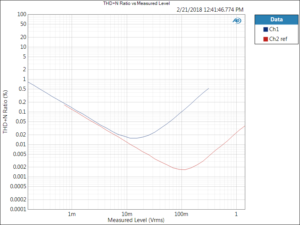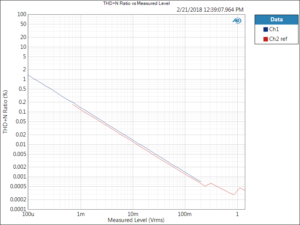Performing some tests on a prototype circuit with an Audio Precision AP515 it was noticed that a particular power resistor showed an unexpectedly high amount of distortion, almost 0.5% THD+N.
Four of them were hooked up in series to provide the desired value, and the BNC to test clip leads were used to connect the DUT to the AP515, and alligator clips to hook up the resistors to each other (I’m simplifying the description).
The series connected resistor parts produced this THD+N vs. Level plot which shows an increase in THD+N with level over about 10 mV, which implies the resistors are being very non-linear. While not impossible, it’s never this dramatic.
The red curve is the source loopback, due to the finite source impedance the distortion will show at the circuit input as well; the blue curve is the measurement across the resistor (which has a lower applied voltage, hence the offset curves in these plots). Again this is a simplified description.
Testing other parts produced the expected results:
After much confusion about how this could possibly be it was realized that one alligator clip was only being used on the parts that produced the high distortion. But it’s just a piece of wire…
Despite appearing as a mild mannered alligator clip lead, this particular clip proved to excel at producing distortion. While visually appearing no different than other alligator clip leads, it surely must have magical powers. Or the more likely scenario is corroded connections between the copper wire and unknown metal of the clip produced a small diode effect. This one came from the bottom of the drawer, at the same stratum of parts purchased > 20 years ago.
Of the half dozen leads in use, this was the only green one.



